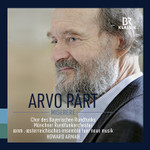|
Back
03/17/2021
“Miserere”
Arvo Pärt: Which Was the Son of... [1] – Festina lente [2] – Tribute to Caesar [3] – Sequentia [4] – The Deer’s Cry [5] – Miserere [6] – Ja ma kuulsin hääle... [7]
Anna-Maria Palii [6] (soprano), Benno Schachtner [6] (alto), Andrew Lepri Meyer, Moon Yung Oh [6] (tenor), Thomas Hamberger [6] (bass), Uta Jungwirth [2, 4] (harp), Stanko Madic [2, 4] (violin), Alexander Fickel [2, 4] (percussion), Bavarian Radio Choir [1, 3, 5, 6, 7], Munich Radio Orchestra [2, 4], Austrian Ensemble for New Music [6], Howard Arman (conductor)
Recording: BR Studio 1, Munich (May 15, 2020 [2] and September 8-11, 2020 [1, 3, 5, 7]), Residenz Hercules Hall, Munich (November 9-10, 2020) [4]) & Mozarteum Foundation (live) (July 21, 2019 [6]) – 71’54
BR Klassik # BRK900527 (Distributed by Naxos of America), Booklet in German and English

   
Arvo Pärt is one of the most beloved composers of religious music of our time for not only the beauty and meaning of his work, but for his authenticity and integrity. His work seems to flow effortlessly out of the great church traditions of Eastern Europe, including works by “name” composers such as Tchaikovsky and Rachmaninoff, as well as the anonymous liturgical scores that stretch back hundreds of years.
Pärt’s works have a contemplative quality and refer harmonically and melodically to spiritually oriented compositions of the past. But despite their reference to familiar conventions, they have a contemporary edge, in part created by Pärt’s own tintinnabuli style, which he developed in 1976. In this style, inspired by the study of ancient chants, Pärt pits arpeggios (broken chords) against diatonic-scale steps (do, re, mi and so forth) to create a unique context for both the pace and flow of his compositions.
In his new album, “Miserere”, Pärt explores despair, atonement, and forgiveness in 21 verses of stunning variety, painted in slow, deliberate strokes with somber hues. A musical cousin of the Requiem, this Miserere, composed in 1992, is a setting of Psalm 51 (King James Version). Added to the verses is a “Dies irae”, familiar as the emotional hotspots in Requiems by Verdi and Berlioz. Traditionally, a Miserere is sung during Holy Week, the period of mourning and reflection leading up to Easter Sunday. Most famous of Misereres is a setting by Allegri which the child Mozart was reputed to have jotted down from memory after only one hearing at the Vatican.
Howard Arman leads the Munich Radio Orchestra and the Bavarian Radio Choir, two ensembles for which he serves as artistic director, in a performance that seems to step outside of time, draped by shimmering beauty and at times as oppressive as the weight of sackcloth and ashes.
In this reading, the work opens in stark nakedness as a tenor voice maintains a monotone of almost unwaveringly intensity, alternating with a clarinet that skips about in search of a home tonality. “Miserere mei, Deus...”, that is to say, “Have mercy upon me, O God...” The arrangement of voices and instruments varies in each verse, opening up the meaning and creating a personalized, powerful impact in each stanza. Considering that the total work feels longer than its 34-minute length, each verse is short and compact, ranging from 54 seconds to just under four minutes.
The next two verses continue the lamentation in chamber-music sized portions, hardly preparing us at all for the explosive “Dies irae”, a shocking roar of chorus and orchestra suggesting the terrors of Armageddon. In the post-Freudian, not Biblical, world, these terrors seem to arise within the individual psyche rather than on some theological plane depicted by Dante. This is clearly the most emotionally charged section of the work and one well worth listening to whether one is a person of faith or not.
I did not hear the organ until the verse, “Redde mihi laetitiam...” or “Restore unto me the joy of thy salvation...”, which concludes with a toccata-like air in the style of Bach, at the same time disorienting (since nothing so far in this work has prepared us for Bach) and delightful (because, like Bach, it is pure beauty). With more imaginative groupings of voices and instruments, the work leads us to an elevated conclusion, in which everything fades to a single organ note that hovers at B-natural for about 15 seconds. We ache to hear this note resolve down to a natural E, but it fades away, like the last breath of life.
This album also contains six selections by Pärt from Biblical or other religious texts, including Which was the Son of... (a setting of the “begat” verses in Luke), Tribute to Caesar (“render unto Caesar the things that are Caesar’s”), The Deer’s Cry (St. Patrick’s Breastplate, as it’s sometimes known). Throughout this album, the Orchestra and Choir warmly express the inner meaning of the text and provide transparent clarity to Pärt’s own elucidation, through music, of the relationship between the spirit and the secular world.
Linda Holt
|